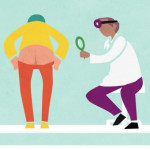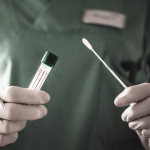A single dose of the human papillomavirus (HPV) vaccine may provide as much protection as the currently recommended two or three doses, according to a new study. A simpler dosing schedule could potentially improve uptake, thereby reducing cancers caused by the virus.
“If ongoing clinical trials provide evidence regarding sustained benefits of a one-dose regimen, then implications of [a] single-dose strategy could be substantial for reducing the burden of these cancers globally,” senior study author Ashish Deshmukh, PhD, MPH, of the University of Texas Health Science Center School of Public Health said in a press release.
HPV is one of the most common sexually transmitted infections, and most people acquire some of the more than 150 known types of the virus soon after they become sexually active. HPV triggers abnormal cell growth that can lead to genital and anal warts, precancerous cell changes and, if left undetected and untreated, cancer of the cervix, anus, vulva, vagina, penis, mouth and throat.
A recent report from the Centers for Disease Control and Prevention (CDC) found that nearly 35,000 people in the United States develop HPV-related cancers each year, and more than 90% of these are caused by the nine viral types covered by the current HPV vaccine, Gardasil 9 (types 6, 11, 16, 18, 31, 33, 45, 52 and 58).
Another recent study found that as HPV vaccine coverage increased in the United States, the prevalence of the four HPV types included in the original Gardasil vaccine (6, 11, 16 and 18) declined by 86% among women ages 14 to 19 and by 71% among those ages 20 to 24.
Experts recommend vaccination for girls and boys at age 11 or 12, with catch-up vaccines for those not immunized as adolescents. Last June, the CDC recommended vaccination for all women and men through age 26. The vaccine is approved for adults up to age 45, and vaccination for those ages 27 to 45 is a shared decision to be made by patients and their providers.
CDC guidelines say that people who are vaccinated before age 15 should receive two doses, with the second shot administered six months to a year after the first. Those vaccinated at older ages should receive three doses, with the second dose given one to two months after the first dose and the third dose administered six months after the first shot.
But the new study suggests that a single dose may be equally effective.
More than a decade after the introduction of the first HPV vaccine, only about half of American adolescents have completed the vaccine series, while about 68% have received at least one dose, the researchers noted as background. Ongoing clinical trials are evaluating the effectiveness of a single-dose regimen.
Deshmukh’s team evaluated the prevalence the four HPV types in the original Gardasil vaccine among women according to the number of vaccine doses they had received. They analyzed data from the 2009 to 2016 National Health and Nutritional Examination Survey (NHANES), an ongoing study assessing the health and nutritional status of adults and children in the United States.
As described in JAMA Network Open, the researchers identified 1,620 women ages 18 to 26 with available data on self-reported HPV vaccination status and HPV test results. A majority were white and the average age was 22. Of these, 1,004 were unvaccinated, 106 had received one dose, 126 had received two doses and 384 had received three doses.
HPV types 6, 11, 16 and 18 were less common among women who had received one, two or three doses of the vaccine compared with unvaccinated women. Prevalence rates in these groups were 2.4%, 5.1%, 3.1% and 12.5%, respectively.
Women who had received any vaccine doses were significantly less likely to have these HPV types than unvaccinated women, meaning the differences were probably not due to chance. But there was no significant difference in HPV rates between women who received one versus two doses or one versus three doses, suggesting that a single dose offers a similar degree of protection.
The study also found that Black women were more likely to have the four HPV types than white women (10.8% versus 6.6%, respectively), and women with more than five male sex partners in their lifetime had a higher probability of infection than those with five or fewer partners (11.6% versus 3.3%, respectively).
“The current HPV vaccine dosing regimen can be cumbersome for people to understand. If one dose is proven effective in trials, the vaccine regimen will be simplified,” said lead author Kalyani Sonawane, PhD, also from the University of Texas Health Science Center School of Public Health. “This will help improve the coverage rate among adolescents that [is] currently below the Healthy People 2020 goal and possibly will also increase the momentum of uptake in the newly approved age group.”
Along with an inconvenient dosing schedule, other barriers to HPV vaccination include lack of awareness that the virus causes cancer, parental reluctance, providers’ failure to recommend the vaccine and lack of access to health care or insurance coverage. HPV vaccination was approved for girls and young women several years before boys and young men, and the benefits for boys and men remain less well known.
The same research team recently reported that 79% of women and just 53% of men ages 18 to 26 knew about the HPV vaccine. Just over 30% of women and 60% of men in this age group did not know that HPV causes cervical cancer. Nearly 90% of men and almost 80% of women were unaware that HPV can cause oral, anal and penile cancers. What’s more, only 19% of men and 32% of women who were eligible for the vaccine or had eligible family members had received a vaccination recommendation from a health care provider.
“HPV vaccination campaigns have focused heavily on cervical cancer prevention in women,” Deshmukh said in another press release. “Our findings demonstrate a need to educate both sexes regarding HPV and HPV vaccination. Rates of cervical cancer have declined in the last 15 to 20 years because of screening. On the other hand, there was a greater than 200% increase in oropharyngeal [mouth and throat] cancer rates in men and a nearly 150% rise in anal cancer rates in women.”
Click here to read the single-dose vaccine study abstract.
Click here to learn more about cervical, anal and oral cancer.







Comments
Comments